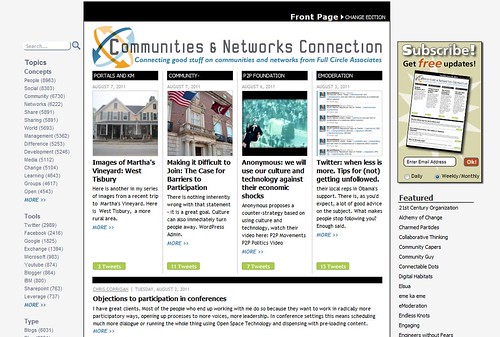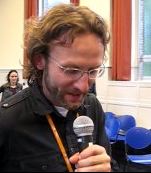 Sometimes I am a silly goose. I help sponsor a great aggregation site, the Communities and Networks Connection, but I lose track of it on my own radar. I do get the highlights via an email subscription (look at the right side of the page) and thought I’d offer a little glimpse, a temptation, if you will, to the site.
Sometimes I am a silly goose. I help sponsor a great aggregation site, the Communities and Networks Connection, but I lose track of it on my own radar. I do get the highlights via an email subscription (look at the right side of the page) and thought I’d offer a little glimpse, a temptation, if you will, to the site.
Best of Communities and Networks Connection
Week of July 30, 2011
- Google Plus and Twitter How They Work for Me Hand in HandELSUA|MONDAY, AUGUST 1, 2011
- It’s been over a month since I first started making use of Google Plus. Yes, me, too!, I still can’t believe I have been there for that long already! But I am back to Twitter. No, I haven’t given up on Google Plus either. Quite Quite the opposite! So what’s happening then? Yes, indeed! Of course, who wouldn’t, right?
- 24 Tweets
- Twitter: when less is more. Tips for (not) getting unfollowed.EMODERATION|WEDNESDAY, AUGUST 3, 2011
- The news that @barackobama has apparently hemorrhaged 35,00 followers in the past few days has set the social media world sniggering with schadenfreude. These were the followers who presumably didn’t appreciate being spammed with 113 tweets in the space of a few hours, exhorting them to tweet-lobby (twobby?) their local reps in Obama’s support.
- 12 Tweets
- Vertaisrahasto.fi (Peer Fund)P2P FOUNDATION|MONDAY, AUGUST 1, 2011
- Vertaisrahasto.fi (literally Peer Fund&# ) is a new way of collecting and allocating funding for research. The idea is very simple. There are two roles for volunteer participants: donors and applicants. Everyone is invited to donate to the fund, the minimum sum is 10 euros. Donations are piled up during a predesignated time.
- 7 Tweets
- Made by Many teams up with Good for Nothing to support the East Africa famine crisisMADE BY MANY|THURSDAY, AUGUST 4, 2011
- Made by Many is partnering with ethical innovators Good for Nothing in a rapid and collaborative response to the East Africa crisis. One child is dying every six minutes, and fundraising efforts are struggling to keep up to fund the relief effort. And we count you all in that network, so please step in and get involved. We need your ideas.
- 33 Tweets
- Traditional Media brainwashing Australians about Social MediaLAUREL PAPWORTH- SOCIAL NETWORK STRATEGY|SUNDAY, JULY 31, 2011
- NSW Police have been made aware of a Facebook page that has allegedly made disturbing death threats against baby-faced singer Jack Vidgen. Telephones don t stalk children, Social Media doesn t intimidate them either. People do. Investigate People. Don t blame the online community tools. usually don t bother clicking anymore.
- 51 Tweets
- Objections to participation in conferencesCHRIS CORRIGAN|TUESDAY, AUGUST 2, 2011
- I have great clients. Most of the people who end up working with me do so because they want to work in radically more participatory ways, opening up processes to more voices, more leadership. In conference settings this means scheduling much more dialogue or running the whole thing using Open Space Technology and dispensing with pre-loading content.
- 11 Tweets
- Community activist hub: right problem, wrong solutionSOCIAL REPORTER|SATURDAY, JULY 30, 2011
- I m puzzled by the recommendation for a central information hub for community activists&# from the Government s Champion for Active Safer Communities, Baroness Newlove. I m sure that Baroness Newlove has good evidence of a demand for information from her work in local communities in recent months so, right problem.
- 8 Tweets
- Social Media at Work ELSUA MONDAY, AUGUST 1, 2011
- Last week, upon my return from my last business trip, I was hoping to be able to resume my regular blogging activities and share with you folks some of the interesting conversations I have been engaging with and other interesting resources worth while sharing across. never ever blog whenever you are upset about something, or someone!
- 11 Tweets
- Hot-Desking: Good or Bad for Collaboration?MICHAEL SAMPSON – CURRENTS|TUESDAY, AUGUST 2, 2011
- New Zealand’s Stuff website asks whether hot-desking is hot or not? : ” Once upon a time, an employee’s desk was a home away from home. Adorned with paraphernalia of hobbies and interests and obligatory family photos, it was as much a statement of identity as it was a place to perform a job. But this cosy space is slowly being taken away.
- 6 Tweets
- Living “A World Without Email” in Google Plus ELSUA|WEDNESDAY, AUGUST 3, 2011
- In the last few weeks a lot has been written about whether Google Plus is the ultimate killer social networking site of Facebook, Twitter, LinkedIn, or several others, you name it. still think it s a bit too early to be announcing the painful death of each of those social networking environments. G+ still needs to reach that level. Or not.
- 12 Tweets
- Book of the Week (2): David Graeber’s take on the fake economics and their Imaginary Myth of Barter P2P FOUNDATION|WEDNESDAY, AUGUST 3, 2011
- Facebook allows merging of community Pages into official Pages EMODERATION|THURSDAY, AUGUST 4, 2011
- Help Complete the Intranet-Digital Workplace Trends 2011 Survey PORTALS AND KM|TUESDAY, AUGUST 2, 2011
- How Come I Can’t Tune Klout? ALCHEMY OF CHANGE|WEDNESDAY, AUGUST 3, 2011
- Book of the Week: David Graeber’s First Five Thousand Years of Debt P2P FOUNDATION|MONDAY, AUGUST 1, 2011
- Network Weaving: The 5 Kinds of Communities JOHN TROPEA – DELICIOUS COMMUNITY|TUESDAY, AUGUST 2, 2011
- How the internet creates ecological/relational forms of awareness P2P FOUNDATION|WEDNESDAY, AUGUST 3, 2011
- Instant Business Guide to LinkedIn THE BUMBLE BEE|THURSDAY, AUGUST 4, 2011
- Forrester Groundswell 2011 Awards: AT&T Proving the ROI of Social Media for Customer Service< ANT’S EYEVIEW BLOG|TUESDAY, AUGUST 2, 2011
- Arab Spring inspires Israeli social justice movement P2P FOUNDATION|MONDAY, AUGUST 1, 2011
- High Performance Companies Collaborate | Podio Blog JOHN TROPEA – DELICIOUS COLLABORATION|TUESDAY, AUGUST 2, 2011
- Wheeeeeeeee!!!!!!!!!! ENDLESS KNOTS|THURSDAY, AUGUST 4, 2011
- Odd names and ordinariness NEIGHBOURHOODS|WEDNESDAY, AUGUST 3, 2011
- The snowflake model: Marshall Ganz on how technology has changed organizing revolutions P2P FOUNDATION|SUNDAY, JULY 31, 2011
- Uploading to Youtube – it’s a snap (ha!) ENDLESS KNOTS|THURSDAY, AUGUST 4, 2011
- Together: a union approach to precariat P2P FOUNDATION|SATURDAY, JULY 30, 2011
- Elinor Ostrom on Going Beyond the Tragedy of the Commons P2P FOUNDATION|TUESDAY, AUGUST 2, 2011
- Police occupy Puerta del Sol #spanishrevolution #nopararemos P2P FOUNDATION|WEDNESDAY, AUGUST 3, 2011
- The insuffficiency of efficiency P2P FOUNDATION |TUESDAY, AUGUST 2, 2011
- The P2P of Zion (2): Social Economy developments within the Mormon Church P2P FOUNDATION|THURSDAY, AUGUST 4, 2011
- From systems of co-determination to full industrial democracy? P2P FOUNDATION|SATURDAY, JULY 30, 2011

 should not be acting as chair of discussion– neither necessary or helpful. More about holding the space, backchannel matchmaking/connecting, draw out the quite – pastoral care behind the scenes. Then the energy the participants bring to the discussion doesn’t get blocked. I don’t think you can lead discussions online, you can only nudge them
should not be acting as chair of discussion– neither necessary or helpful. More about holding the space, backchannel matchmaking/connecting, draw out the quite – pastoral care behind the scenes. Then the energy the participants bring to the discussion doesn’t get blocked. I don’t think you can lead discussions online, you can only nudge them